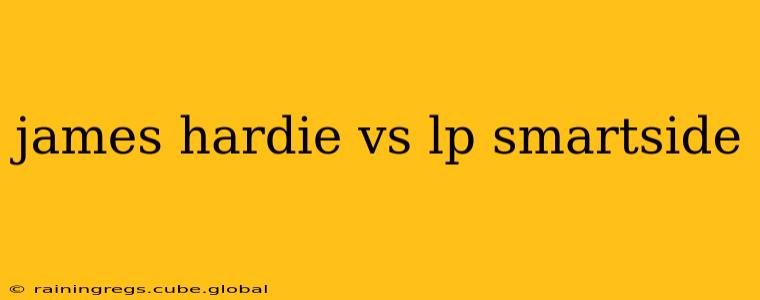Choosing the right siding for your home is a significant decision, impacting both aesthetics and long-term durability. Two leading contenders consistently top homeowners' lists: James Hardie and LP SmartSide. Both offer attractive options with impressive warranties, but understanding their key differences is crucial for making an informed choice. This comprehensive comparison will help you decide which siding best suits your needs and budget.
What is James Hardie Siding?
James Hardie siding is crafted from fiber cement, a composite material blending cement, cellulose fibers, and sand. This composition results in a remarkably durable product resistant to fire, rot, insects, and extreme weather conditions. Its strength and resilience translate to a siding option known for its longevity. James Hardie offers a wide range of styles and colors, mimicking the look of wood, stucco, or brick.
What is LP SmartSide Siding?
LP SmartSide siding is engineered wood, treated with a proprietary process to enhance its resistance to moisture, rot, and insect infestation. This treatment significantly extends its lifespan compared to untreated wood siding. While not as fire-resistant as fiber cement, LP SmartSide offers a more budget-friendly alternative with a pleasing wood-like appearance. It also comes in various styles and color options.
James Hardie vs. LP SmartSide: Key Differences
Here's a head-to-head comparison of crucial factors:
Durability and Longevity
- James Hardie: Boasts superior durability due to its fiber cement composition. It's exceptionally resistant to impact, fire, and harsh weather conditions, leading to a significantly longer lifespan. Expect decades of worry-free performance.
- LP SmartSide: While significantly more durable than untreated wood, it's still susceptible to more damage than James Hardie. Proper installation and maintenance are crucial to maximize its lifespan. Expect a good lifespan, but potentially shorter than James Hardie.
Cost
- James Hardie: Generally, more expensive than LP SmartSide due to its superior materials and manufacturing process. The higher upfront cost is often offset by its longer lifespan and reduced maintenance.
- LP SmartSide: Offers a more budget-friendly option, making it attractive to homeowners working with tighter budgets. However, consider the potential for higher maintenance and replacement costs over the long term.
Maintenance
- James Hardie: Requires minimal maintenance. Occasional cleaning with water and a soft brush is usually sufficient.
- LP SmartSide: While treated, it may require more maintenance than James Hardie, including occasional repainting or staining to maintain its appearance and protect against the elements.
Appearance and Styles
- James Hardie: Offers a wide array of styles and colors, replicating the looks of wood, stucco, and brick with impressive accuracy. The textures and finishes are often considered more sophisticated.
- LP SmartSide: Also offers a variety of styles and colors, primarily mimicking the look of wood. The options may be slightly less diverse than James Hardie.
Which siding is better for high-wind areas?
Both James Hardie and LP SmartSide are designed to withstand strong winds, but James Hardie's superior strength and resilience give it a slight edge in exceptionally windy regions. Proper installation for both is crucial regardless of location.
Which siding is more resistant to fire?
James Hardie siding is significantly more fire-resistant than LP SmartSide due to its non-combustible fiber cement composition. This makes it a superior choice in areas with a higher risk of wildfires.
Which siding is more environmentally friendly?
Both manufacturers have made strides in sustainability. However, LP SmartSide, being engineered wood, uses a renewable resource. James Hardie's fiber cement utilizes recycled materials to a certain extent, but the manufacturing process can be more energy-intensive. The "greenest" choice depends on the specific manufacturing practices and transportation distances involved. Check each company's sustainability reports for detailed information.
How long do James Hardie and LP SmartSide siding last?
The lifespan of both sidings varies based on climate, installation, and maintenance. However, James Hardie generally boasts a longer lifespan, often exceeding 50 years. LP SmartSide typically lasts 30-50 years with proper care.
Conclusion
The "best" siding depends entirely on your individual needs and priorities. James Hardie provides superior durability, fire resistance, and longevity but comes at a higher initial cost. LP SmartSide offers a more budget-friendly option with good durability, but may require more maintenance over its lifetime. Carefully weigh the pros and cons of each to make the best decision for your home and budget. Remember to consult with a reputable siding contractor to get personalized recommendations and accurate installation quotes.
